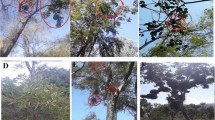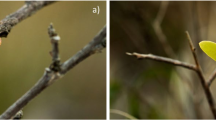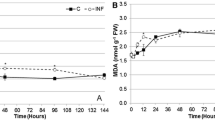Abstract
Mistletoes are parasitic plants that are capable of penetrating the living tissue of another plant’s stems and branches and extracting the necessary resources for their survival. This study aimed to compare the leaves and branches of parasitized and non-parasitized Tapirira guianensis host trees to gain insights of reciprocal effects of Phoradendron perrottetii (mistletoe) infection and profiles of primary metabolites and phenolic compounds of T. guianensis. Our hypothesis was that either the host’s chemical profile determines mistletoe infestation, or that the mistletoe infestation leads to fundamental changes in the metabolite profile of the host. Plant material was collected from T. guianensis parasitized by P. perrottetii, yielding samples from infested and non-infested host branches and their respective leaves. Infested branches were divided into two regions, the proximal region and the host-parasite interface (gall) region. Leaves and branches of non-parasitized plants were also collected. Statistical analyses revealed negative effects of the parasite on infested branches regarding most of the analyzed primary metabolites, especially soluble carbohydrates. This suggests a flow of carbohydrates towards the mistletoe, indicating a partially heterotrophic nutrition. Additionally, we observed a positive effect on the tannin contents of non-infested host branches caused by the mistletoe, which might suggest that this parasitic relationship induces a systemic response in T. guianensis. Finally, high contents of flavonoids at the gall region could indicate a mechanism of ROS quenching.



Similar content being viewed by others
References
Adler LS (2000) Alkaloid uptake increases fitness in a hemiparasitic plant via reduced herbivory and increased pollination. Am Nat 156:92–99
Agati G, Azzarello E, Pollastri S, Tattini M (2012) Flavonoids as antioxidants in plants: location and functional significance. Plant Sci 196:67–76
Aharoni A, Galili G (2011) Metabolic engineering of the plant primary–secondary metabolism interface. Curr Opin Biotechnol 22:239–244. https://doi.org/10.1016/j.copbio.2010.11.004
Ahmad MU, Husain SK, Osman SM (1981) Ricinoleic acid in Phyllanthus niruri seed oil. J Am Oil Chem Soc 58:673–674
Alvino FO, Silva MFF, Rayol BP (2005) Potencial de uso das espécies arbóreas de uma floresta secundária, na Zona Bragantina, Pará, Brasil. Acta Amazon 35:413–420
Amaral LIV, Gaspar M, Costa PMF, Aidar MPM, Buckeridge MS (2007) Novo método enzimático rápido e sensível de extração e dosagem de amido em materiais vegetais. Hoehnea 34:425–431
Apel K, Hirt H (2004) Reactive oxygen species: metabolism, oxidative stress, and signal transduction. Annu Rev Plant Biol 55:373–399. https://doi.org/10.1146/annurev.arplant.55.031903.141701
Arnold T, Appel H, Patel V, Stocum E, Kavalier A, Schultz J (2004) Carbohydrate translocation determines the phenolic content of Populus foliage: a test of the sink-source model of plant defense. New Phytol 164:157–164. https://doi.org/10.1111/j.1469-8137.2004.01157.x
Arruda R, Fadini RF, Carvalho LN, Del-Claro K, Mourão FA, Jacobi CM, Teodoro GS, Van den Berg E, Caires CS, Dettke GA (2012) Ecology of neotropical mistletoes: an important canopy-dwelling component of Brazilian ecosystems. Acta Bot Braz 26:264–274
Baxter A, Mittler R, Suzuki N (2014) ROS as key players in plant stress signaling. J Exp Bot 65:1229–1250. https://doi.org/10.1093/jxb/ert375
Boros CA, Marshall DR, Caterino CR, Stermitz FR (1991) Iridoid and phenylpropanoid glycosides from Orthocarpus spp. alkaloid content as a consequence of parasitism on Lupinus. J Nat Prod 54:506–513
Bouwmeester HJ, Matusova R, Zhongkui S, Beale MH (2003) Secondary metabolite signalling in host–parasitic plant interactions. Curr Opin Plant Biol 6:358–364. https://doi.org/10.1016/S1369-5266(03)00065-7
Bowie M, Ward D (2004) Water and nutrient status of the mistletoe Plicosepalus acaciae parasitic on isolated Neveg Desert populations of Acacia raddiana differing in level of mortality. J Arid Environ 56:487–508. https://doi.org/10.1016/S0140-1963(03)00067-3
Bringmann G, Schlauer J, Rückert M, Wiesen B, Ehrenfeld K, Proksch P, Czygan FC (1999) Host-derived acetogenins involved in the incompatible parasitic relationship between Cuscuta reflexa (Convolvulaceae) and Ancistrocladus heyneanus (Ancistrocladaceae). Plant Biol 1:581–584
Broshot NE, Tinnin RO (1986) The effect of dwarf mistletoe on starch concentrations in the twigs and needles of lodgepole pine. Can J For Res 16:658–660
Buchanan BB, Gruissem W, Jones RL (2015) Biochemistry and molecular biology of plants. Wiley, Chichester
Caretto S, Linsalata V, Colella G, Mita G, Lattanzio V (2015) Carbon fluxes between primary metabolism and phenolic pathway in plant tissues under stress. Int J Mol Sci 16:26378–26394. https://doi.org/10.3390/ijms161125967
Cocoletzi E, Angeles G, Ceccantini G, Patrón A, Ornelas JF (2016) Bidirectional anatomical effects in a mistletoe–host relationship: Psittacanthus schiedeanus mistletoe and its hosts Liquidambar styraciflua and Quercus germana. Am J Bot 103:986–997. https://doi.org/10.3732/ajb.1600166
Conrath U (2006) Systemic acquired resistance. Plant Signal Behav 1:179–184. https://doi.org/10.4161/psb.1.4.3221
Costa LCB, Rocha EA, Silva LAM, Jardim JG, Silva DC, Gaião LO, Moreira RCT (2006) Levantamento preliminar das espécies vegetais com potencial econômico no Parque Municipal da Boa Esperança, Ilhéus, Bahia, Brasil. Acta Farm Bonaer 25:184–191
Cuevas-Reyes P, Pérez-López G, Maldonado-López Y, González-Rodríguez A (2017) Effects of herbivory and mistletoe infection by Psittacanthus calyculatus on nutritional quality and chemical defense of Quercus deserticola along Mexican forest fragments. Plant Ecol 218:687–697. https://doi.org/10.1007/s11258-017-0721-2
Cunha LVFC, Albuquerque UP (2006) Quantitative ethnobotany in an Atlantic Forest fragment of Northeastern Brazil—implications to conservation. Environ Monit Assess 114:1–25. https://doi.org/10.1007/s10661-006-1074-9
Dawson TE, King EJ, Ehleringer JR (1990) Age structure of Phoradendron juniperinum (Viscaceae), a xylem-tapping mistletoe: inferences from a non-destructive morphological index of age. Am J Bot 77:573–583
de Souza AP, Arundale RA, Dohleman FG, Long SP, Buckeridge MS (2013) Will the exceptional productivity of Miscanthus × giganteus increase further under rising atmospheric CO2? Agric For Meteorol 171:82–92
Dinakar C, Djilianov D, Bartels D (2012) Photosynthesis in desiccation tolerant plants: energy metabolism and antioxidative stress defense. Plant Sci 182:29–41
dos Santos GL, Pereira MG, de Carvalho DC, dos Santos RN, Delgado RC, Torres JLR, Cravo MDS (2017) Relationship between the environmental conditions and floristic patterns in two phytophysiognomies of the Brazilian Cerrado. Environ Dev Sustain. https://doi.org/10.1007/s10668-017-0025-7
Echevarría-Zomeño S, Pérez-de-Luque A, Jorrín J, Maldonado AM (2006) Pre-haustorial resistance to broomrape (Orobanche cumana) in sunflower (Helianthus annuus): cytochemical studies. J Exp Bot 57:4189–4200. https://doi.org/10.1093/jxb/erl195
Ehleringer JR, Schulze ED, Ziegler H, Lange OL, Farquhar GD, Cowar IR (1985) Xylem-tapping mistletoes: water or nutrient parasites? Science 227:1479–1481
Escher P, Rennenberg H (2006) Influx of double labelled glutamine into mistletoes (Viscum album) from the xylem sap of its host (Abies alba). Plant Physiol Biochem 44:880–884. https://doi.org/10.1016/j.plaphy.2006.09.014
Escher P, Eiblmeier M, Rennenberg H (2004) Differences in the influx of glutamine and nitrate into Viscum album from xylem sap of its hosts. Plant Physiol Biochem 42:739–744. https://doi.org/10.1016/j.plaphy.2004.07.009
Forzza RC, Baumgratz JFA, Bicudo CEM, Carvalho AA Jr, Costa A, Costa DP, Hopkins M, Leitman PM, Lohmann LG, Maia LC, Martinelli G, Menezes M, Morim MP, Coelho MAN, Peixoto AL, Pirani JR, Prado J, Queiroz LP, Souza VC, Stehmann JR, Sylvestre LS, Walter BMT, Zappi D (eds) (2010) Catálogo de plantas e fungos do Brasil. Instituto de Pesquisas Jardim Botânico do Rio de Janeiro, Rio de Janeiro
Foyer CH, Noctor G (2005) Oxidant and antioxidant signalling in plants: a re-evaluation of the concept of oxidative stress in a physiological context. Plant Cell Environ 28:1056–1071
Furlan CM, Santos KP, Sedano-Partida MD, Motta LB, Santos DYAC, Salatino MLF, Negri G, Berry PE, van Ee BW, Salatino A (2015) Flavonoids and antioxidant potential of nine Argentinian species of Croton (Euphorbiaceae). Braz J Bot 38:693–702. https://doi.org/10.1007/s40415-014-0115-9
Gerstner K, Moreno-Mateos D, Gurevitch J, Beckmann M, Kambach S, Jones HP, Seppelt R (2017) Will your paper be used in a meta-analysis? Make the reach of your research broader and longer lasting. Methods Ecol Evol 8:777–784. https://doi.org/10.1111/2041-210X.12758
Glatzel G, Geils BW (2009) Mistletoe ecophysiology: host-parasite interactions. Botany 87:10–15. https://doi.org/10.1139/B08-096
Goldwasser Y, Hershenhorn J, Plakhine D, Kleifeld Y, Rubin B (1999) Biochemical factors involved in vetch resistance to Orobanche aegyptiaca. Physiol Mol Plant Pathol 54:87–96
Griffiths ME, Ruiz N, Ward D (2016) Mistletoe species richness patterns are influenced more by host geographic range than nitrogen content. Afr J Ecol 55:101–110. https://doi.org/10.1111/aje.12328
Hammerschmidt R (2009) Systemic acquired resistance. Adv Bot Res 51:173–222
Hariri EB, Sallé G, Andary C (1991) Involvement of flavonoids in the resistance of two poplar cultivars to mistletoe (Viscum album L.). Protoplasma 162:20–26
Harrison F (2011) Getting started with meta-analysis. Methods Ecol Evol 2:1–10. https://doi.org/10.1111/j.2041-210X.2010.00056.x
Heide-Jørgensen HS (2008) Parasitic flowering plants. Brill, Leiden
Hernández I, Alegre L, Breusegem FV, Munné-Bosch S (2009) How relevant are flavonoids as antioxidants in plants? Trends Plant Sci 14:125–132. https://doi.org/10.1016/j.tplants.2008.12.003
Hosseini SM, Kartoolinejad D, Mirnia SK, Tabibzadeh Z, Akbarinia M, Shayanmehr F (2008) The European mistletoe effects on leaves and nutritional elements of two host species in Hyrcanian Forests. Silva Lusitana 16:229–237
IUSS Working Group WRB (2015) World reference base for soil resources 2014, update 2015, International soil classification system for naming soils and creating legends for soil maps. World soil resources reports No. 106. FAO, Rome
Jamil M, Rodenburg J, Charnikhova T, Bouwmeester HJ (2011) Pre-attachment Striga hermonthica resistance of new rice for Africa (NERICA) cultivars based on low strigolactone production. New Phytol 192:964–975. https://doi.org/10.1111/j.1469-8137.2011.03850.x
Khanna SK, Viswanathan PN, Tewari CP, Krishnan PS, Sanwal GG (1968) Biochemical aspects of parasitism by the angiosperm parasites: phenolics in parasites and hosts. Physiol Plant 21:949–959
Knutson DM (1979) How parasitic seed plants induce disease in other plants. In: Horsfall JG, Cowling EB (eds) Plant disease and advanced treatise. v.4. Academic Press, New York, pp 293–312
Kuijt J (2003) Monograph of Phoradendron (Viscaceae). Systematic botany monographs 66. American Society of Plant Taxonomists. https://doi.org/10.2307/25011253
Lamont B (1983) Germination of mistletoes. In: Calder M, Bernhardt P (eds) The biology of mistletoes. Academic Press, São Paulo
Logan BA, Huhn ER, Tissue DT (2002) Photosynthetic characteristics of eastern dwarf mistletoe (Arceuthobium pusillum Peck) and its effects on the needles of host white spruce (Picea glauca [Moench] Voss). Plant Biol 4:740–745
Lozano-Baena MD, Prats E, Moreno MT, Rubiales D, Pérez-de-Luque A (2007) Medicago truncatula as a model for nonhost resistance in legume-parasitic plant interactions. Plant Physiol 145:437–449
Mani MS (1964) Ecology of plant galls. Junk, The Hague
Marshall JD, Ehleringer JR (1990) Are xylem-tapping mistletoes partially heterotrophic? Oecologia 84:244–248
Marshall JD, Dawson TE, Ehleringer JR (1993) Gender-related differences in gas exchange are not related to host quality in the xylem-tapping mistletoe, Phoradendron juniperinum (Viscaceae). Am J Bot 80:641–645
Marshall JD, Dawson TE, Ehleringer JR (1994) Integrated nitrogen, carbon, and water relations of a xylem-tapping mistletoe following nitrogen fertilization of the host. Oecologia 100:430–438
Mathiasen RL, Nickrent DL, Shaw DC, Watson DM (2008) Mistletoes: pathology, systematics, ecology, and management. Plant Dis 92:988–1006. https://doi.org/10.1094/PDIS-92-7-0988
Mead EW, Looker M, Gardner DR, Stermitz FR (1992) Pyrrolizidine alkaloids of Liatris punctata and its root parasite, Castilleja integra. Phytochemistry 31:3255–3257
Meinwald J, Eisner T (2008) Chemical ecology in retrospect and prospect. PNAS 105:4539–4540. https://doi.org/10.1073/pnas.0800649105
Mohamed A, Ellicott A, Housley TL, Ejeta G (2003) Hypersensitive response to Striga infection in Sorghum. Crop Sci 43:1320–1324
Nakagawa S, Cuthill IC (2007) Effect size, confidence interval and statistical significance: a practical guide for biologists. Biol Rev 82:591–605. https://doi.org/10.1111/j.1469-185X.2007.00027.x
Neumann U, Vian B, Weber HC, Sallé G (1999) Interface between haustoria of parasitic members of the Scrophulariaceae and their hosts: a histochemical and immunocytochemical approach. Protoplasma 207:84–97
Norton DA, Ladley JJ, Sparrow AD (1997) Development of non-destructive age indices for three New Zealand loranthaceous mistletoes. New Zeal J Bot 35:337–343
Okubamichael DY, Griffiths ME, Ward D (2016) Host specificity in parasitic plants-perspectives from mistletoes. AoB Plants 8:plw069. https://doi.org/10.1093/aobpla/plw069
Pate JS (2001) Haustoria in action: case studies of nitrogen acquisition by woody xylem-tapping hemiparasites from their hosts. Protoplasma 215:204–217
Pate JS, True KC, Rasins E (1991) Xylem transport and storage of amino acids by S.W. Australian mistletoes and their hosts. J Exp Bot 42:441–451. https://doi.org/10.1093/jxb/42.4.441
Pennings SC, Callaway RM (2002) Parasitic plants: parallels and contrasts with herbivores. Oecologia 131:479–489. https://doi.org/10.1007/s00442-002-0923-7
Popp M, Richter A (1998) Ecophysiology of xylem-tapping mistletoes. Prog Bot 59:659–674
Press MC, Graves JD (1995) Parasitic plants. Chapman & Hall, London
Press MC, Phoenix GK (2005) Impacts of parasitic plants on natural communities. New Phytol 166:737–751. https://doi.org/10.1111/j.1469-8137.2005.01358.x
Rezende FM, de Souza AP, Buckeridge MS, Furlan CM (2015) Is guava phenolic metabolism influenced by elevated atmospheric CO2? Environ Pollut 196:483–488
Richter A, Popp M (1992) The physiological importance of accumulation of cyclitols in Viscum album L. New Phytol 121:431–438
Richter A, Popp M, Mensen R, Stewart GR, von Willert DJ (1995) Heterotrophic carbon gain of the parasitic Angiosperm Tapinanthus oleifolius. Aust J Plant Physiol 22:537–544
Roumy V, Fabre N, Portet B, Bourdy G, Acebey L, Vigor C, Valentin A, Moulis C (2009) Four anti-protozoal and anti-bacterial compounds from Tapirira guianensis. Phytochemistry 70:305–311
Runyon JB, Mescher MC, De Moraes CM (2010a) Plant defenses against parasitic plant show similarities to those induced by herbivores and pathogens. Plant Signal Behav 5:929–931. https://doi.org/10.4161/psb.5.8.11772
Runyon JB, Mescher MC, Felton GW, De Moraes CM (2010b) Parasitism by Cuscuta pentagona sequentially induces JA and SA defense pathways in tomato. Plant Cell Environ 33:290–303. https://doi.org/10.1111/j.1365-3040.2009.02082.x
Sangüesa-Barreda G, Linares JC, Camarero JJ (2012) Mistletoe effects on Scots pine decline following drought events: insights from within-tree spatial patterns, growth and carbohydrates. Tree Physiol 32:585–598. https://doi.org/10.1093/treephys/tps031
Santos ACR, Furlan CM (2013) Levels of phenolic compounds in Tibouchina pulchra after fumigation with ozone. Atmos Pollut Res 4:250–256. https://doi.org/10.5094/APR.2013.027
Scalon MC, Wright IJ (2015) A global analysis of water and nitrogen relationships between mistletoes and their hosts: broad-scale tests of old and enduring hypotheses. Funct Ecol 29:1114–1124. https://doi.org/10.1111/1365-2435.12418
Scharpf RF, Parmeter JR (1966) Determining the age of dwarf mistletoe infections on red fir. US Forest Serv Res Note PSW 105:1–5
Schilmiller AL, Howe GA (2005) Systemic signaling in the wound response. Curr Opin Plant Biol 8:369–377. https://doi.org/10.1016/j.pbi.2005.05.008
Schulze ED, Turner NC, Glatzel G (1984) Carbon, water and nutrient relations of two mistletoes and their hosts: a hypothesis. Plant Cell Environ 7:293–299
Sharma P, Jha AB, Dubey RS, Pessarakli M (2012) Reactive oxygen species, oxidative damage, and antioxidative defense mechanism in plants under stressful conditions. J Bot 2012:217037. https://doi.org/10.1155/2012/217037
Smith JL, De Moraes CM, Mescher MC (2009) Jasmonate- and salicylate-mediated plant defense responses to insect herbivores, pathogens and parasitic plants. Pest Manag Sci 65:497–503. https://doi.org/10.1002/ps.1714
Smith JD, Woldemariam MG, Mescher MC, Jander G, De Moraes CM (2016) Glucosinolates from host plants influence growth of the parasitic plant Cuscuta gronovii and its susceptibility to aphid feeding. Plant Physiol 172:181–197
Souza VC, Lorenzi H (2008) Botânica Sistemática: guia ilustrado para identificação das famílias de Fanerógamas nativas e exóticas no Brasil, baseado em APG II. Instituto Plantarum, Nova Odessa
Stermitz FR, Belofsky GN, Ng D, Singer MC (1989) Quinolizidine alkaloids obtained by Pedicularis semibarbata (Scrophulariaceae) from Lupinus fulcratus (Leguminosae) fail to influence the specialist herbivore Euphydryas editha (Lepidoptera). J Chem Ecol 15:2521–2530
Sullivan GM, Feinn R (2012) Using effect size—or why the P value is not enough. J Grad Med Educ 4:279–282. https://doi.org/10.4300/JGME-D-12-00156.1
Teixeira-Costa L, Ceccantini G (2015) Embolism increase and anatomical modifications caused by a parasitic plant: Phoradendron crassifolium (Santalaceae) on Tapirira guianensis (Anacardiaceae). IAWA J 36:138–151. https://doi.org/10.1163/22941932-00000091
Teixeira-Costa L, Ceccantini G (2016) Aligning microtomography analysis with traditional anatomy for a 3D understanding of the host-parasite interface—Phoradendron spp. case study. Front Plant Sci 7:1340. https://doi.org/10.3389/fpls.2016.01340
Terrazas T, Wendt T (1995) Systematic wood anatomy of the genus Tapirira Aublet (Anacardiaceae)—a numerical approach. Brittonia 47:109–129
Těšitel J (2016) Functional biology of parasitic plants: a review. Plant Ecol Evol 149:5–20. https://doi.org/10.5091/plecevo.2016.1097
Tjiurutue MC, Sandler HA, Kersch-Becker MF, Theis N, Adler LA (2016) Cranberry resistance to dodder parasitism: induced chemical defenses and behavior of a parasitic plant. J Chem Ecol 42:95–106. https://doi.org/10.1007/s10886-016-0671-5
Villacís J, Casanoves F, Hang S, Keesstra S, Armas C (2016) Selection of forest species for the rehabilitation of disturbed soils in oil fields in the Ecuadorian Amazon. Sci Total Environ 566:761–770
Walters DR (2011) Plant defense: warding off attack by pathogens, herbivores, and parasitic plants. Wiley-Blackwell, Oxford
Waterman PG, Mole S (1994) Analysis of phenolic plant metabolites. Blackwell Scientific Publications, Oxford
Watson DM (2009) Determinants of parasitic plant distribution: the role of host quality. Botany 87:16–21. https://doi.org/10.1139/B08-105
Watson DM (2017) On tropical mistletoes: tractable models for evolutionary ecology, ecosystem function, and phytochemistry. Botany 95:211–217. https://doi.org/10.1139/cjb-2016-0232
Wilson DB (2018) Practical meta-analysis effect size calculator [Online calculator]. Retrieved from https://www.campbellcollaboration.org/research-resources/research-for-resources/effect-size-calculator.html. Accessed 26 Jan 2018
Yahraus T, Chandra S, Legendre L, Low PS (1995) Evidence for a mechanically induced oxidative burst. Plant Physiol 109:1259–1266
Yan CF, Gessler A, Rigling A, Dobbertin M, Han XG, Li MH (2016) Effects of mistletoe removal on growth, N and C reserves, and carbon and oxygen isotope composition in Scots pine hosts. Tree Physiol 36:562–575. https://doi.org/10.1093/treephys/tpw024
Zamith LR, Scarano FR (2006) Restoration of a restinga randy coastal plain in Brazil: survival and growth of planted woody species. Restor Ecol 14:87–94
Acknowledgements
Authors would thank Mourisa Ferreira and Aline Bertinatto Cruz for their technical assistance during analysis; Jessica Gersony for improvements on the first version of the manuscript. GC and CMF were fellow researchers of the Brazilian Council for Superior Education (CNPq).
Funding
Authors would thank the São Paulo Research Foundation for funding this research (FAPESP—process number 2013/23322-3) and CAPES (Finance Code 001, Brazil).
Author information
Authors and Affiliations
Corresponding author
Ethics declarations
Conflict of interest
The authors declare that they have no conflict of interest.
Additional information
Communicated by Marko Rohlfs.
Electronic supplementary material
Below is the link to the electronic supplementary material.
Rights and permissions
About this article
Cite this article
Anselmo-Moreira, F., Teixeira-Costa, L., Ceccantini, G. et al. Mistletoe effects on the host tree Tapirira guianensis: insights from primary and secondary metabolites. Chemoecology 29, 11–24 (2019). https://doi.org/10.1007/s00049-018-0272-6
Received:
Accepted:
Published:
Issue Date:
DOI: https://doi.org/10.1007/s00049-018-0272-6




